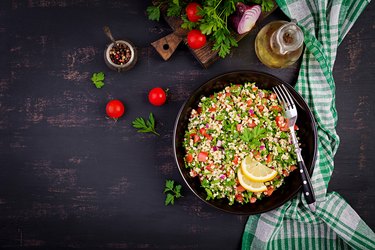
Changing your diet to more healthy foods will improve your health in the long run. Diets with lots of fruits and vegetables can prevent disease and improve your body functions. But because of the side effects of switching to a healthy diet, you may encounter some unexpected, short-term roadblocks.
Changing to a Healthy Diet Symptoms
Video of the Day
Harvard Health says a diet rich in fruits and vegetables can lower your blood pressure, cut your risk of heart disease and stroke, help prevent certain cancers, as well as help control your blood sugar and your appetite. Eating leafy green vegetables and fruits like apples and pears with low glycemic loads can prevent spikes in blood sugar.
Video of the Day
But changing to a healthy diet has symptoms that can include intestinal gas, stomach bloating and cramping. According to the Mayo Clinic, adding too much fiber too fast can cause these. Instead, increase fiber gradually in your diet over a few weeks. This allows the natural bacteria in your digestive system to adjust to the changes you've made.
The Mayo Clinic also suggests that as you add more high-fiber foods to your diet, drink more water. When fiber has plenty of water to absorb, it helps to make your stool soft and bulky.
Advantages to Your New Diet
You may be worried that your healthier eating habits will leave you feeling hungry. Or perhaps you are delaying changing your diet because you don't want to feel hungry all the time. The Mayo Clinic, however, says that high-fiber foods are actually more filling than low-fiber foods, so you are less likely to have that desire to eat more food.
These same foods that are more filling are typically lower in calories, the Mayo Clinic adds. This means you'll be taking in fewer calories for the same amount of food you're eating. But you'll be helping your body in the long run, even as it adjusts to higher-fiber foods.
Men under 50 should get 38 grams of fiber a day, while women under 50 should get 25 grams per day. Men over 50 should get 30 grams of fiber per day, while women over 50 should get 20 grams per day. The National Academies of Sciences, Engineering and Medicine issued these recommendations in 2002, but the National Institutes of Health Office of Dietary Supplements still recommends these levels.
Good Fiber Choices
Making these good choices in fiber may bring along some gas, bloating and cramping. But knowing these choices will benefit your health in the long run should outweigh these diet change side effects.
The Mayo Clinic recommends you get fiber from these foods:
- Whole-grain products
- Fruits
- Vegetables
- Beans, peas and other legumes
- Nuts and seeds
Any time you change your diet, however, make sure you check with your doctor. If you have food allergies, make sure you take these into consideration as you make your dietary changes.
On the other hand, if you start eating some of these foods and continually notice something's not right, check with your doctor to see if you have a food allergy or other underlying problem. Making the right modifications for you may take just a bit more tinkering, and you can do this with a professional.
- Harvard School of Public Health: "The Nutrition Source: Vegetables and Fruits"
- Mayo Clinic: "Healthy Lifestyle: Nutrition and Healthy Eating"
- National Institutes of Health Office of Dietary Supplements: "Nutrient Recommendations: Dietary Reference Intakes"
- National Academies of Sciences, Engineering, Medicine: "Dietary Reference Intakes for Energy, Carbohydrate, Fiber, Fat, Fatty Acids, Cholesterol, Protein, and Amino Acids"